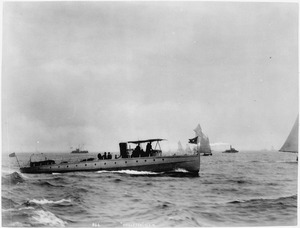 Stiletto in 1891 | |
| History | |
|---|---|
| Builder | Herreshoff Manufacturing Co. |
| Laid down | 1885 |
| Acquired | 3 March 1887 |
| In service | July 1887 |
| Stricken | 27 January 1911 |
| Fate | Sold for scrap 18 July 1911 |
| General characteristics | |
| Displacement | 31 tons |
| Length | 94 ft (29 m) |
| Beam | 11 ft 6 in (3.51 m) |
| Draft | 5 ft (1.5 m) |
| Speed | 23.3 knots |
| Complement | 6 |
USS Stiletto, a wooden torpedo boat, was launched in 1885 at the Herreshoff Manufacturing Co., Bristol, Rhode Island, as a private speculation. She was purchased for the United States Navy under an Act of Congress dated 3 March 1887, and entered service in July 1887, attached to the Naval Torpedo Station in Newport Rhode Island.



